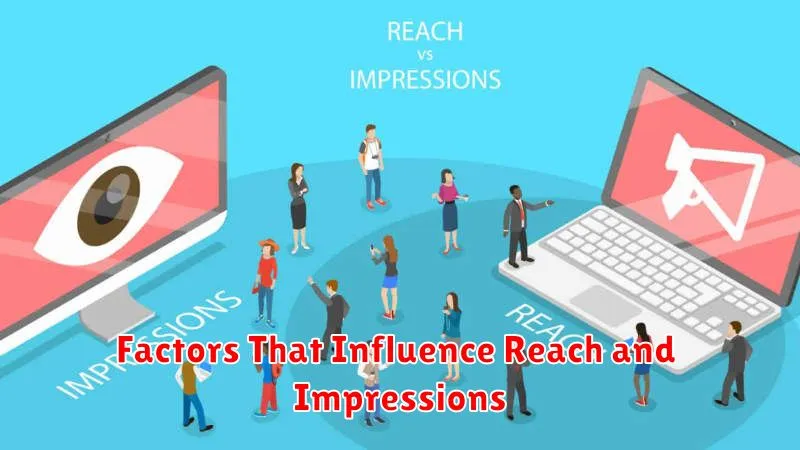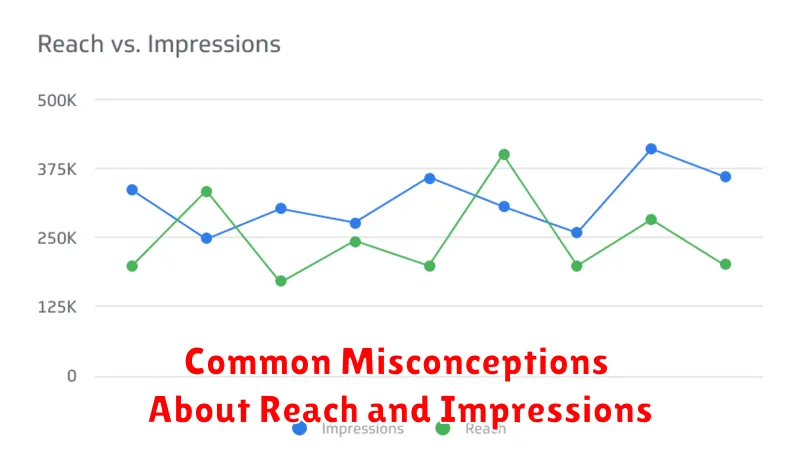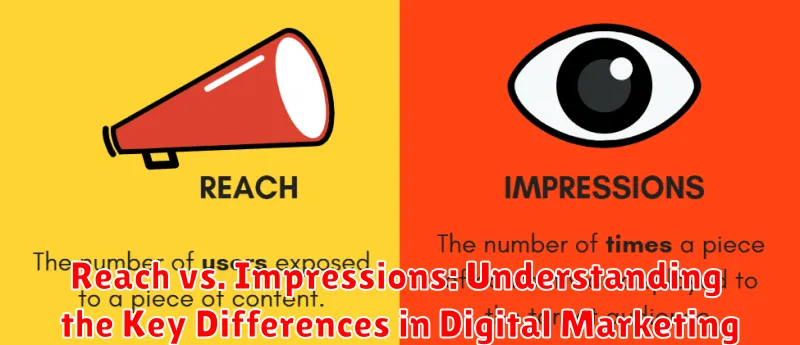In the complex landscape of digital marketing, understanding key metrics is paramount to success. Two metrics often confused, yet fundamentally different, are reach and impressions. Discerning the nuances between these two is crucial for crafting effective campaigns, optimizing ad spend, and ultimately, achieving your marketing objectives. This article will delve into the core differences between reach and impressions, providing clear definitions and practical examples to solidify your understanding.
While both reach and impressions offer valuable insights into the performance of your digital marketing efforts, they provide distinct perspectives. Reach refers to the number of unique individuals exposed to your content, while impressions represent the total number of times your content is displayed, regardless of whether it’s seen by the same individual multiple times. Mastering the distinction between these two metrics empowers marketers to accurately gauge the effectiveness of their campaigns and make data-driven decisions. This understanding is essential for optimizing your digital marketing strategy and maximizing your return on investment.
Defining Reach and Impressions
In the realm of digital marketing, reach and impressions are two fundamental metrics that offer valuable insights into campaign performance. However, they are often confused. Understanding their distinct meanings is crucial for accurate analysis and effective strategy development.
Reach refers to the number of unique individuals exposed to your content or advertisement. It represents the overall audience size you’ve managed to connect with. It’s important to note that one person can only be counted once as part of your reach, regardless of how many times they’ve seen your ad.
Impressions, on the other hand, measure the total number of times your content or advertisement is displayed, regardless of whether it was seen by a unique individual. This means one person can contribute multiple impressions if they encounter your ad several times.
Illustrating the Difference with Examples
Let’s clarify the distinction between reach and impressions with a few practical examples.
Example 1: Television Commercial
Imagine a commercial airing during a popular television program. If 10,000 people watch the program, the commercial’s reach is 10,000. If the commercial airs three times during the program, the total impressions would be 30,000 (10,000 x 3).
Example 2: Social Media Post
Consider a post on a social media platform. If 2,000 unique users see your post, your reach is 2,000. If 500 of those users see the post twice, your impressions are 2,500 (2,000 + 500).
Example 3: Billboard Advertisement
A billboard placed on a busy highway may be seen by an estimated 5,000 drivers daily. This 5,000 represents the reach. If each driver passes the billboard twice a day on average, the daily impressions are 10,000 (5,000 x 2).
How Reach and Impressions Are Calculated
Understanding how reach and impressions are calculated is crucial for accurate data interpretation. While seemingly simple, the calculations have nuances depending on the platform.
Reach is generally calculated by counting the number of unique users exposed to a piece of content. If one user sees your ad five times, they are still counted as one reach. Platforms use various methods like cookies, device IDs, and IP addresses to track unique users, minimizing duplication.
Impressions, on the other hand, represent the total number of times your content is displayed, regardless of whether it was seen by a unique user. So, if one user sees your ad five times, that contributes five impressions. The calculation is simply a count of every instance the content is served.
It’s important to note that these calculations can vary slightly across platforms due to differing methodologies. Always refer to the specific platform’s documentation for precise details on their calculation methods.
The Importance of Both Metrics in Measuring Campaign Success
Both reach and impressions play crucial roles in evaluating the success of your digital marketing campaigns, offering different but complementary insights. Reach helps you understand how effectively your campaign is expanding its audience and attracting new potential customers. A wider reach suggests your message is being seen by a diverse group, increasing brand awareness and potential market penetration.
Impressions, on the other hand, indicate the total volume of exposure your campaign is generating. High impression counts can reinforce brand messaging and improve recall, especially when targeting a specific audience segment. Analyzing impressions helps determine the frequency with which your audience encounters your content, a crucial factor for campaigns focused on driving conversions or promoting specific actions.
By considering both metrics together, marketers gain a comprehensive understanding of campaign performance. For instance, high reach with low impressions might suggest a broad but superficial exposure, while low reach with high impressions may indicate a highly targeted but potentially saturated audience. Balancing these two metrics is key for optimizing campaign strategy and achieving desired marketing objectives.
Factors That Influence Reach and Impressions

Several factors can significantly influence both reach and impressions. Understanding these factors is crucial for interpreting your data and optimizing your campaigns.
Factors Influencing Reach
Targeting: Narrow targeting can limit reach, while broader targeting can increase it. Content Quality and Relevance: Engaging content is more likely to be shared, thereby increasing organic reach. Platform Algorithm: Each platform’s algorithm plays a significant role in determining how content is distributed and, consequently, its reach. Budget: For paid campaigns, budget directly influences the potential reach.
Factors Influencing Impressions
Frequency: Higher frequency of posting can lead to more impressions, but can also negatively impact reach if it leads to users hiding or unfollowing your content. Campaign Duration: Longer campaigns generally generate more impressions. Viral Content: Highly shareable content can drastically increase impressions organically. Ad Placements: Choosing the right ad placements can increase the visibility of your ads and lead to a higher impression count.
Using Reach and Impressions to Optimize Your Campaigns
Leveraging reach and impression data is crucial for optimizing your digital marketing campaigns. By understanding these metrics, you can make informed decisions to improve performance and achieve your marketing objectives.
Low Reach, High Impressions: If your campaign has high impressions but low reach, it might indicate that you’re over-saturating the same audience. Consider broadening your targeting criteria to reach a wider audience or diversifying your content to appeal to different segments.
High Reach, Low Impressions: Conversely, high reach with low impressions suggests your content may not be engaging enough to generate repeat views. Analyze your content strategy and experiment with different formats, messaging, and calls to action to increase user interaction.
Balancing Reach and Frequency: Finding the right balance between reach and frequency is essential. Too much frequency can lead to ad fatigue and a decrease in engagement, while too little frequency may not be sufficient to build brand awareness or drive conversions. Monitor these metrics and adjust your campaign parameters accordingly to find the optimal frequency for your target audience.
A/B Testing: Use A/B testing to experiment with different ad creatives, targeting parameters, and bidding strategies. By analyzing the impact of these variations on reach and impressions, you can identify what resonates best with your audience and optimize your campaigns for maximum effectiveness.
Common Misconceptions About Reach and Impressions

Several misconceptions can cloud the understanding of reach and impressions. One common mistake is assuming that high impressions automatically translate to high reach. While related, they are distinct. Impressions count multiple views by the same individual, while reach only counts each unique individual once, regardless of how many times they see the content.
Another misconception is believing that a larger reach is always better. While reaching a broader audience can be beneficial, a highly targeted campaign with smaller reach but higher engagement might be more effective depending on the campaign objective. A highly niche product, for instance, benefits from precise targeting over broad reach.
Finally, some believe reach and impressions are the sole indicators of a successful campaign. While valuable, they should be analyzed alongside other key performance indicators (KPIs) like engagement, click-through rates, and conversions to provide a holistic view of campaign performance.
Tools for Tracking Reach and Impressions
Various tools provide data on reach and impressions, helping marketers monitor campaign performance. Platform-native analytics are often the first go-to. For example, platforms like Facebook, Instagram, Twitter, and LinkedIn offer built-in analytics dashboards showing reach and impression data for campaigns run on their respective platforms.
Third-party social listening and analytics tools offer a broader perspective, often aggregating data across multiple platforms. These tools can provide more in-depth analysis and competitive benchmarking.
For website analytics, Google Analytics is a primary tool. It doesn’t directly measure social media reach, but it does track impressions on your website through pageviews, providing valuable insight into how social media efforts drive traffic. It also offers information on user demographics and behavior, allowing for a comprehensive understanding of your audience.
Finally, many marketing automation platforms and social media management suites consolidate data from various sources into a central dashboard. These dashboards typically include reach and impression metrics alongside other key performance indicators (KPIs), providing a holistic view of campaign performance.

